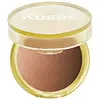What's inside
What's inside
 Key Ingredients
Key Ingredients

 Benefits
Benefits

 Concerns
Concerns

 Ingredients Side-by-side
Ingredients Side-by-side

Mica
Cosmetic ColorantLimnanthes Alba Seed Oil
Skin ConditioningHydrogenated Vegetable Oil
EmollientCaprylic/Capric Triglyceride
MaskingSilica
AbrasiveHectorite
AbsorbentSoybean Glycerides
EmollientPhenethyl Alcohol
MaskingTocopheryl Acetate
AntioxidantCaprylyl Glycol
EmollientButyrospermum Parkii Butter Unsaponifiables
Skin ConditioningButyrospermum Parkii Butter Extract
Skin ConditioningOleic/Linoleic/Linolenic Polyglycerides
EmollientSorbitan Tristearate
EmulsifyingAscorbyl Palmitate
AntioxidantCI 77163
Cosmetic ColorantCI 77491
Cosmetic ColorantCI 77492
Cosmetic ColorantCI 77499
Cosmetic ColorantCI 77891
Cosmetic ColorantMica, Limnanthes Alba Seed Oil, Hydrogenated Vegetable Oil, Caprylic/Capric Triglyceride, Silica, Hectorite, Soybean Glycerides, Phenethyl Alcohol, Tocopheryl Acetate, Caprylyl Glycol, Butyrospermum Parkii Butter Unsaponifiables, Butyrospermum Parkii Butter Extract, Oleic/Linoleic/Linolenic Polyglycerides, Sorbitan Tristearate, Ascorbyl Palmitate, CI 77163, CI 77491, CI 77492, CI 77499, CI 77891
Caprylic/Capric Triglyceride
MaskingNeopentyl Glycol Dicaprylate/Dicaprate
EmollientMica
Cosmetic ColorantSqualane
EmollientSilica
AbrasiveSynthetic Wax
AbrasiveHelianthus Annuus Seed Wax
Skin ConditioningDisteardimonium Hectorite
StabilisingZea Mays Starch
AbsorbentCamellia Sinensis Leaf Extract
AntimicrobialLithospermum Erythrorhizon Root Extract
Skin ConditioningHaematococcus Pluvialis Extract
AntioxidantGlycyrrhiza Glabra Root Extract
BleachingGlyceryl Undecylenate
EmollientGlyceryl Laurate
EmollientCaprylyl Glycol
Emollient1,2-Hexanediol
Skin ConditioningTin Oxide
AbrasiveCI 77891
Cosmetic ColorantCI 77491
Cosmetic ColorantCI 77499
Cosmetic ColorantCaprylic/Capric Triglyceride, Neopentyl Glycol Dicaprylate/Dicaprate, Mica, Squalane, Silica, Synthetic Wax, Helianthus Annuus Seed Wax, Disteardimonium Hectorite, Zea Mays Starch, Camellia Sinensis Leaf Extract, Lithospermum Erythrorhizon Root Extract, Haematococcus Pluvialis Extract, Glycyrrhiza Glabra Root Extract, Glyceryl Undecylenate, Glyceryl Laurate, Caprylyl Glycol, 1,2-Hexanediol, Tin Oxide, CI 77891, CI 77491, CI 77499
Ingredients Explained
These ingredients are found in both products.
Ingredients higher up in an ingredient list are typically present in a larger amount.
This ingredient is an emollient, solvent, and texture enhancer. It is considered a skin-softener by helping the skin prevent moisture loss.
It helps thicken a product's formula and makes it easier to spread by dissolving clumping compounds.
Caprylic Triglyceride is made by combining glycerin with coconut oil, forming a clear liquid.
While there is an assumption Caprylic Triglyceride can clog pores due to it being derived from coconut oil, there is no research supporting this.
Learn more about Caprylic/Capric TriglycerideCaprylyl Glycol is a humectant and emollient, meaning it attracts and preserves moisture.
It is a common ingredient in many products, especially those designed to hydrate skin. The primary benefits are retaining moisture, skin softening, and promoting a healthy skin barrier.
Though Caprylyl Glycol is an alcohol derived from fatty acids, it is not the kind that can dry out skin.
This ingredient is also used as a preservative to extend the life of products. It has slight antimicrobial properties.
Learn more about Caprylyl GlycolCi 77491 is also hydrated iron III oxide. It's sole purpose is to give a red/pink hue to products.
Iron III oxides are classified as inorganic chemicals for coloring.
Synthetically created Ci 77491 is considered safer than those naturally found. This is because the synthetically created version may contain less impurities. Iron oxides are generally non-toxic and non-allergenic.
Learn more about CI 77491Ci 77499 is also hydrated iron III oxide. It is created from mixing red and black iron oxides. This helps give shades of darkness to a product.
Iron III oxides are classified as inorganic chemicals for coloring.
Ci 77891 is a white pigment from Titanium dioxide. It is naturally found in minerals such as rutile and ilmenite.
It's main function is to add a white color to cosmetics. It can also be mixed with other colors to create different shades.
Ci 77891 is commonly found in sunscreens due to its ability to block UV rays.
Learn more about CI 77891Mica is a naturally occurring mineral used to add shimmer and color in cosmetics. It can also help improve the texture of a product or give it an opaque, white/silver color.
Serecite is the name for very fine but ragged grains of mica.
This ingredient is often coated with metal oxides like titanium dioxide. Trace amounts of heavy metals may be found in mica, but these metals are not harmful in our personal products.
Mica has been used since prehistoric times throughout the world. Ancient Egyptian, Indian, Greek, Roman, Aztec, and Chinese civilizations have used mica.
Learn more about MicaSilica, also known as silicon dioxide, is a naturally occurring mineral. It is used as a fine, spherical, and porous powder in cosmetics.
Though it has exfoliant properties, the function of silica varies depending on the product.
The unique structure of silica enhances the spreadability and adds smoothness, making it a great texture enhancer.
It is also used as an active carrier, emulsifier, and mattifier due to its ability to absorb excess oil.
In some products, tiny microneedles called spicules are made from silica or hydrolyzed sponge. When you rub them in, they lightly polish away dead skin layers and enhance the penetration of active ingredients.
Learn more about Silica